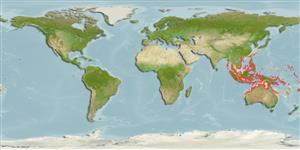Common names from other countries
Teleostei (teleosts) >
Eupercaria/misc (Various families in series Eupercaria) >
Labridae (Wrasses) > Bodianinae
Etymology: Bodianus: Bodianus after Bodiano or Pudiano, from the Portuguese pudor, meaning modesty (Jordan & Evermann, 1896).; mesothorax: Name from the Greek mesos for middle, and masculine noun thorax or breast plate; apparently in reference to the prominent diagonal black band on the body of adults of this species (Ref. 75973).
More on authors: Bloch & Schneider.
Environment: milieu / climate zone / depth range / distribution range
Ecology
Marine; reef-associated; depth range 0 - 60 m (Ref. 128797), usually 5 - 20 m (Ref. 27115). Subtropical; 24°C - 28°C (Ref. 27115); 32°N - 24°S
Western Pacific between Wakayama Pref., Japan and Sydney, Australia, New Caledonia and Fiji. Indian Ocean, along the western coast of Malaysia and Indonesia, and at least in the Nicobars at the edge of the Andaman Sea. Evidently excluded from the oceanic mid-Pacific plate;
Size / Weight / Age
Maturity: Lm ? range ? - ? cm
Max length : 25.0 cm TL male/unsexed; (Ref. 30874)
Dorsal
spines
(total): 12;
Dorsal
soft rays
(total): 9-10;
Anal
spines: 3;
Anal
soft rays: 11 - 12. Juveniles and adults resemble their counterparts of B. axillaris, but juveniles have yellow rather than white spots and adults have well-defined black band between the light and dark portions of the body and lack ocelli on the dorsal and anal fins. Color of juveniles changes completely to adult pattern when about 5-6 cm long. The change takes only a few weeks and intermediates are rarely seen (Ref. 48636).
Ranging into subtropical zones as juveniles expatriate caused by warm currents during pelagic stage (Ref. 48636). Adults inhabit coral-rich outer reef slopes at depths of 5 to over 20 m, particularly near caves. Juveniles in caves; adults swim openly about, but usually close to the substrate, and often engage in cleaning larger fishes (Ref. 48636). Oviparous, distinct pairing during breeding (Ref. 205).
Life cycle and mating behavior
Maturity | Reproduction | Spawning | Eggs | Fecundity | Larvae
Oviparous, distinct pairing during breeding (Ref. 205).
Gomon, M.F., 2006. A revision of the labrid fish genus Bodianus with descriptions of eight new species. Rec. Aust. Mus. Suppl. 30:1-133. (Ref. 75973)
IUCN Red List Status (Ref. 130435)
CITES (Ref. 128078)
Not Evaluated
Threat to humans
Harmless
Human uses
Aquarium: commercial
Tools
Special reports
Download XML
Internet sources
Estimates based on models
Preferred temperature (Ref.
115969): 26.5 - 29, mean 28.1 (based on 528 cells).
Phylogenetic diversity index (Ref.
82804): PD
50 = 0.5000 [Uniqueness, from 0.5 = low to 2.0 = high].
Bayesian length-weight: a=0.01202 (0.00551 - 0.02625), b=3.05 (2.87 - 3.23), in cm Total Length, based on LWR estimates for this Genus-body shape (Ref.
93245).
Trophic level (Ref.
69278): 3.2 ±0.36 se; based on food items.
Resilience (Ref.
120179): Medium, minimum population doubling time 1.4 - 4.4 years (Preliminary K or Fecundity.).
Fishing Vulnerability (Ref.
59153): Low vulnerability (15 of 100).
